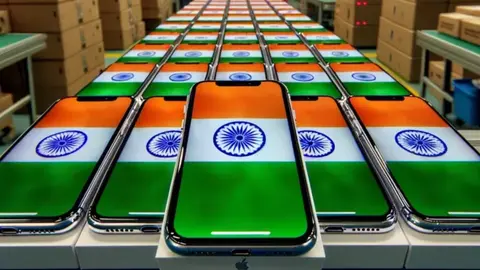Counterpoint has released its report on India’s smartphone shipments for the second quarter (Q2) of 2024. The findings show a 2% decline in shipments compared to the same period last year. This downturn is attributed to several factors, including heat waves, a seasonal slowdown, and reduced demand.
Factors Behind the Decline
1. Heat Waves and Seasonal Slowdowns
One of the key reasons for the drop in smartphone shipments is the extreme heat waves across various regions. These heat waves have led to fewer people visiting offline stores, as they prefer to stay indoors to avoid the harsh weather. Additionally, the seasonal downturn typically seen in Q2 has further contributed to the reduced demand.
2. Shift in Consumer Priorities
With rising temperatures, consumers have prioritized buying electrical appliances like air conditioners and refrigerators over smartphones. This shift in spending has caused a delay in smartphone purchases, leading to an accumulation of unsold inventory.
Brand Performance in Q2 2024
Xiaomi Takes the Lead
Despite the overall decline in shipments, Xiaomi has managed to reclaim the top spot in the Indian market. With a shipment share of 18.9%, Xiaomi leads the pack, showcasing its strong presence and consumer preference in India.
Xiaomi came to the Indian phone market in July 2014 with its Mi 3 phone. It sold only through Flipkart, using a flash sale model. This made much hype, and the Mi 3 sold out in minutes. Xiaomi’s mix of good specs and low prices made a big hit with Indian users. The company’s win in India came from a few key points. First, Xiaomi gave great value for money. Phones like the Redmi line were loved for their low cost, good features, and solid work. Next, Xiaomi used online sales well, teaming up with big e-sellers like Flipkart, Amazon, and later its own Mi.com to reach many buyers.
By 2017, Xiaomi was the top phone brand in India, a spot it kept for many months. This lead came from low prices, a big sales network, and good service after the sale. Xiaomi’s local plan, like setting up plants in India under “Make in India,” helped too. This cut costs and let the brand act fast to what users wanted.
Xiaomi kept growing by making new things, like smart home stuff and gadgets. The Mi Home stores gave users a real shop to try and buy things, which worked well with its online sales. Even with strong rivals like Samsung, Realme, and Vivo, Xiaomi kept its top spot. Its focus on what users think, always making things better, and smart ads helped a lot. As of 2024, Xiaomi is still a strong name in the Indian phone market, known for its mix of low cost, good quality, and new ideas.
Vivo and Samsung Follow Close Behind
Vivo secured the second spot in the Indian smartphone market in Q2 2024, capturing an 18.8% market share. This narrow gap with Xiaomi underscores Vivo’s strong performance and competitive strategy. Vivo’s success can be attributed to its focus on both mid-range and high-end smartphones, appealing to a broad spectrum of consumers. The brand’s emphasis on camera technology and innovative features has resonated well with Indian users, further solidifying its market position.
Samsung, while slipping to third place with an 18.1% market share, remains a formidable presence in the Indian smartphone market. The brand’s decline in rank is attributed to intensified competition and shifting consumer preferences. Despite the decline in market share, Samsung continues to leverage its strengths in technology and customer trust. The company’s focus on incorporating advanced features such as high-resolution displays, versatile camera systems, and robust performance has helped it maintain a loyal customer base. Samsung’s extensive service network and reliable after-sales support further contribute to its strong market presence. As the market evolves, both brands will need to continue innovating and addressing consumer needs to strengthen their positions and capture more market share.
Apple didn’t make the top 5
Missing out of the top 5 list in a large market like India is not a good report for Apple India. India is the second largest mobile phone market in the world behind China. Apple’s market share in India’s overall smartphone market remains relatively small, at about 5.1%, compared to its competitors, particularly in the flagship segment where it primarily operates. However, there is a growing segment for premium smartphones, constituting 10% of total shipments, up from 4% before the pandemic. Apple has been strategically positioning itself to benefit from this trend by increasing its retail presence and local manufacturing efforts
High-End Smartphone Segment
While the overall market declined, the high-end smartphone segment (models priced above 45,000 Indian rupees) experienced significant growth. Shipments of high-end models in India increased by 24% year-on-year in Q2 2024. This growth indicates a rising demand for premium smartphones among Indian consumers.
In terms of high-end smartphone shipments, Samsung leads the market with a 25% share. Vivo and Apple follow in second and third place, respectively. This dominance in the high-end segment underscores Samsung’s strong position in the premium market.
Conclusion
The Q2 2024 report from Counterpoint highlights the challenges faced by the Indian smartphone market, including reduced shipments due to heat waves, seasonal downturns, and shifting consumer priorities. Despite these challenges, Xiaomi remains at the top of the mobile phone market in India. Other brands like Vivo and Samsung continue to compete fiercely for market share.
It will be crucial for smartphone brands to adapt to changing consumer preferences and market conditions. The high-end segment’s growth in India indicates a shift towards premium models, while the overall market’s recovery will depend on addressing the factors that led to the decline in shipments. As brands continue to innovate and compete, the smartphone market is poised for dynamic changes in the coming quarters.
